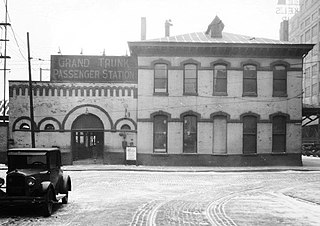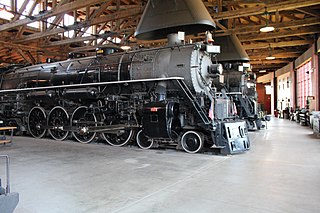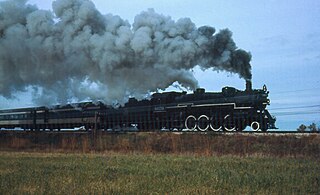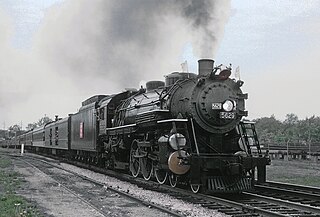Related Research Articles
The Detroit, Toledo and Ironton Railroad operated from 1905 to 1983 between its namesake cities of Detroit, Michigan, and Ironton, Ohio, via Toledo. At the end of 1970, it operated 478 miles of road on 762 miles of track; that year it carried 1,244 million ton-miles of revenue freight.

The Grand Trunk Western Railroad Company was an American subsidiary of the Grand Trunk Railway, later of the Canadian National Railway operating in Michigan, Illinois, Indiana, and Ohio. Since a corporate restructuring in 1971, the railroad has been under CN's subsidiary holding company, the Grand Trunk Corporation. Grand Trunk Western's routes are part of CN's Michigan Division. Its primary mainline between Chicago and Port Huron, Michigan serves as a connection between railroad interchanges in Chicago and rail lines in eastern Canada and the Northeastern United States. The railroad's extensive trackage in Detroit and across southern Michigan has made it an essential link for the automotive industry as a hauler of parts and automobiles from manufacturing plants.

The St. Clair Tunnel is the name for two separate rail tunnels which were built under the St. Clair River between Sarnia, Ontario and Port Huron, Michigan. The original, opened in 1891 and used until it was replaced by a new larger tunnel in 1995, was the first full-size subaqueous tunnel built in North America. It is a National Historic Landmark of the United States, and has been designated a civil engineering landmark by both US and Canadian engineering bodies.

Brush Street Station was a passenger train station on the eastside of downtown Detroit, Michigan, located at the foot of Brush Street at its intersection with Atwater Street and bordered by the Detroit River to the south.

The Detroit and Toledo Shore Line Railroad is a historic railroad that operated in northwestern Ohio and southeastern Michigan.

Durand Union Station is a historic train station in Durand, Michigan. The station, which now serves Amtrak Blue Water trains, was originally a busy Grand Trunk Western Railroad and Ann Arbor Railroad hub, as well as a local office for Grand Trunk Western, from its construction in 1903 until 1974. It is currently owned by the city of Durand and leased by Durand Union Station, Inc. a nonprofit organization dedicated to the preservation, restoration, and maintenance of the building and its surrounding property.

The International was a named passenger train operated between Chicago and Toronto. It was originally an overnight train operated by the Grand Trunk Railway of Canada and its successors the Canadian National Railway and Grand Trunk Western Railroad, running as far as Montreal. The train was cut back to Port Huron, Michigan, in 1970 and discontinued in 1971.
The Toledo, Saginaw and Muskegon Railway is a defunct railroad incorporated in January, 1886. The railroad offered service between Ashley, Michigan and Muskegon, Michigan starting on August 1, 1888. The Grand Trunk Railway of Canada took control the same day, but the company did not merge with the Grand Trunk Western Railway until 1928.

Grand Trunk Western 6325 is a class "U-3-b" 4-8-4 "Northern" type steam locomotive built in 1942 by the American Locomotive Company (ALCO) for the Grand Trunk Western Railroad. As a member of the dual service U-3-b class, the 6325 handled heavy passenger and freight work for the Grand Trunk Western. In 1946, the 6325 gained notoriety for pulling United States President Harry S. Truman's election campaign train through the state of Michigan. Retired in 1959, the locomotive was donated for display to the City of Battle Creek, Michigan where a failed restoration attempt left 6325 in danger of being scrapped. Purchased in 1993 by Jerry Jacobson of the Ohio Central Railroad, the locomotive sat in storage for six years until being restored to operating condition on July 31, 2001, for use on excursion trains across the Ohio Central System. The locomotive is in storage, on static display at the Age of Steam Roundhouse in Sugarcreek, Ohio.

The USRA Light Pacific was a USRA standard class of steam locomotive designed under the control of the United States Railroad Administration, the nationalized railroad system in the United States during World War I. It was the standard light passenger locomotive of the USRA types, with a 4-6-2 wheel arrangement in the Whyte notation, or 2′C1′ in UIC classification.
Port Huron & Detroit Railroad Company was incorporated on September 1, 1917, in the State of Michigan, United States of America, to own and operate 14 miles (23 km) of railroad track along the Saint Clair River from Port Huron, Michigan, to Marine City, Michigan. It remained in business until it was sold to the Chesapeake & Ohio Railroad in December 1984. Most of its original trackage is still being operated today by CSX Transportation Co. with whom Chesapeake & Ohio Railroad merged into on September 2, 1987.

The Maple Leaf was a passenger train pool operated by the Canadian National and the Grand Trunk Western Railroad between Chicago, Illinois and Toronto, Ontario. It operated from 1927 to 1971. The train took its name from the maple leaf, the national symbol of Canada. The Maple Leaf was one of many trains discontinued when Amtrak began operations in 1971, and is unrelated to the Maple Leaf which Amtrak now operates between Toronto and New York City. The train operated on Canadian National railroad territory through Ontario, but west of Lake Huron it operated via Grand Trunk Railroad.

Grand Trunk Western No. 4070 is an S-3-a class 2-8-2 USRA Light Mikado steam locomotive, and it was originally built by the American Locomotive Company (ALCO) in December 1918 for the Grand Trunk Railway (GTR) as No. 474. It was later re-numbered to 3734 by the Grand Trunk Western (GTW), after the GTR was absorbed into Canadian National (CN). In the late 1950s, the locomotive received a larger tender from an S-3-c class locomotive, and it was further re-numbered to 4070.

Grand Canyon Railway 4960 is a preserved O-1A class 2-8-2 "Mikado" type steam locomotive built in August 1923 by the Baldwin Locomotive Works for the Chicago, Burlington and Quincy (CB&Q) Railroad. It was used by the CB&Q to pull freight trains, until 1958, when the locomotive pulled its first excursion fantrip, as part of the railroad's steam excursion program.

The Chicago Burlington and Quincy O-5 was a class of 36 4-8-4 "Northern" type steam locomotives built by the Baldwin Locomotive Works in 1930 and the Chicago, Burlington and Quincy Railroad (CB&Q) between 1936 and 1940 and operated by the CB&Q until the late 1950s.

Grand Trunk Western No. 6039 is a preserved class "U-1-c" 4-8-2 "Mountain type" steam locomotive built in June 1925 by Baldwin. It served the Grand Trunk Western Railroad by pulling fast passenger and freight trains throughout the Lower Peninsula of Michigan, until the railroad decided to dieselize their locomotive fleet. During that time, it was leased to the Central Vermont Railway for freight service, only to become one of the very last steam locomotives to regularly operate in the state of Vermont. After being retired in the late 1950s, No. 6039 became one of the very first steam locomotives to be owned by F. Nelson Blount, and it subsequently became part of his Steamtown, U.S.A. collection for static display. In 1984, the locomotive was moved along with every other locomotive in the Steamtown collection from Bellows Falls to Scranton, Pennsylvania, where the name would late be changed to Steamtown National Historic Site under the jurisdiction of the National Park Service. As of 2023, No. 6039 remains on static display at Scranton with very meticulous cosmetic care.

Grand Trunk Western No. 6323 is a preserved class "U-3-b" 4-8-4 "Northern" type steam locomotive built by Alco in 1942. It served the Grand Trunk Western Railroad by pulling various heavy freight and passenger trains across the Lower Peninsula of Michigan and Northern Indiana. It became famous in later years for being the very last active steam locomotive to run on the GTW's trackage while still on the railroad's active list in 1961. After sitting in storage for several years in Detroit, No. 6323 was sold in 1981 to the Illinois Railway Museum, and since then, it has remained on static display in Union, Illinois.

Grand Trunk Western 5629 was a 4-6-2 K-4-a steam locomotive, which was a copy of the United States Railroad Administration's (USRA) Light Pacific design, built by American Locomotive Company (ALCO) in 1924, for the Grand Trunk Western Railroad. It was used to haul commuter passenger trains in Michigan until 1960, when it was purchased by Chicago-based railfan Richard Jensen, who used No. 5629 to pull several excursion trains in the Chicago area throughout the 1960s.

Chicago, Burlington and Quincy 5632 was an O-5B class 4-8-4 “Northern” built in the CB&Q's shops in August 1940. It was used to pull mainline passenger and freight trains before it eventually became famous for pulling a plethora of excursion trains for the CB&Q's steam excursion program. By the time the program ended in 1966, No. 5632 was disassembled for an unfinished overhaul, and was subsequently sold to Chicago area railfan Richard Jensen.

Chicago, Burlington and Quincy 4963 is a preserved class "O-1a" 2-8-2 "Mikado" type steam locomotive originally built by the Baldwin Locomotive Works in 1923 for the Chicago, Burlington and Quincy Railroad. It was used by the CB&Q to haul mainline freight trains before it was leased to the Bevier and Southern Railroad to haul short-distance freight trains in the early 1960s. It was subsequently retained by the CB&Q and used as a source of spare parts before being acquired by Richard Jensen.
References
- ↑ Llanso, Steve. "Canadian Government / Canadian National / Canadian Northern / Grand Trunk / Grand Trunk Pacific / Grand Trunk Western / Intercolonial / Reid Newfoundland 4-6-2 Locomotives in Canada". www.steamlocomotive.com. Retrieved July 4, 2023.
- ↑ Dorin (1977), p. 120.
- ↑ Kean (1973), p. 96
- ↑ Grand Trunk Western Railroad Company (1944), p. 57
- ↑ Kean (1973) , p. 96
- ↑ Edwin (1976) , p. 29
- 1 2 3 4 5 6 Pinkepank, Jerry (2003). Grand Trunk Western in Color - Vol 1: Steam & Green, 1941-1961. Scotch Plains, New Jersey: Morning Sun Books, Inc. pp. 64, 67. ISBN 1-58248-112-1.
- 1 2 3 4 5 "Locomotive Enshrined: Durand Marks End of Steam Era". Lansing State Journal. May 21, 1961. p. 10 – via Newspapers.com.
- 1 2 3 Olds, Fred (May 18, 1961). "Old 5632 to Be Dedicated As Steam Era Memorial". Lansing State Journal. p. 36 – via Newspapers.com.
- 1 2 Meints (1987) , p. 7
- 1 2 Hubbard (1965) , p. 32
- ↑ Mahoney, Michelle (July 6, 1987). "Railroad Buffs Steamed by Plan to Scrap Antique Engine (GTW 5629)". Associated Press News . Archived from the original on June 13, 2023. Retrieved June 13, 2023.
- 1 2 "Wreck of Train Kills 2 at Flint". The State Journal. May 29, 1930. pp. 1, 13 – via Newspapers.com.
- 1 2 "Grand Trunk Flier Hits Open Switch; 2 Killed; 5 Injured". Journal and Courier. Vol. 11, no. 128. May 29, 1930. p. 5 – via Newspapers.com.